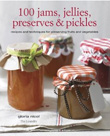EVEN MORE OLD PEGS
Tuesday August 25th 2009, 10:44 pm

I was really pleased with the photographs of my old pegs that I posted a few weeks ago. Since then I’ve acquired even more. It is hard to believe that pegs could come in so many different styles, but the fact that they are all handmade by someone, once, and designed to do a necessary job makes them especially interesting to me. I don’t suppose they were ever considered as things to warrant attention.
The first set of pegs are quite large. They have been turned on a lathe as there are marks in the tops which show where they were attached for turning. I think they are oak but seem to have been stained to give them a rich woody colour.

The second set are again quite big, clumsy and chunky, hewn from untreated oak. The tops are square and have been thoughtfully bevelled at the corners, to make them more comfortable to handle when being pushed down onto the washing line.
The last set look like conventional dolly pegs but, though my photo doesn’t really convey it, they are child sized, each peg only 6cm long. They are like the first pegs given to me as a child by my Aunt Lily, who always gave the best presents and had an innate sense for what you’d want more than anything in the world. Whoever owned these little pegs hand stitched a flannel bag to keep them in. Small nimble fingers sewed on a press stud fastening to keep the pegs safe and tidy.
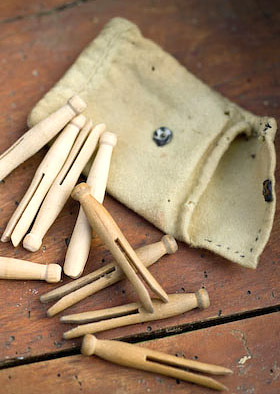
At My Corner Shop
Tuesday May 19th 2009, 5:21 pm
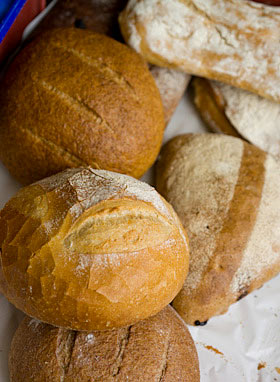
One of the great advantages of opening my shop, The Laundry at Taurus, is that La Bodega has become my corner shop. La Bodega, the on-site organic delicatessen at Taurus Crafts is in fact the nearest food shop to my home, but now I only have to walk a matter of yards to pick up ingredients each day for lunch or dinner and I get the pick of the fresh produce the moment it arrives, either just harvested from the nearby market garden or delivered from other local suppliers.
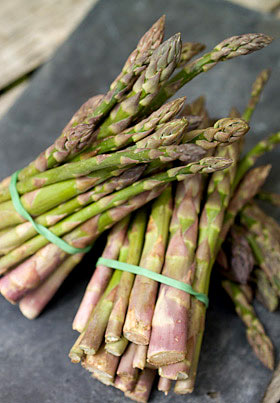
Friday is the day the fresh bread is delivered from a local artisan bakery. I haven’t made a sourdough loaf in ages as it is now just too easy to grab one from the deli. It is such a delicious sight when the trays, piled high with loaves, arrive and I make sure I’m near the front of the queue.

As well as the food and comestibles on sale, my neighbour, Jane Hale, sells her ‘country bunches’ there too; fabulous and subtle bouquets of wild and cultivated flowers and foliage. Many of her blooms are grown in her own country-style garden and she mixes in other stems of foliage and wild flowers gathered from the surrounding hedgerow and roadside and she always manages to capture the beauty, colour and fleeting quality of the countryside.
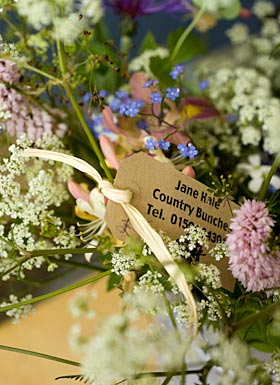
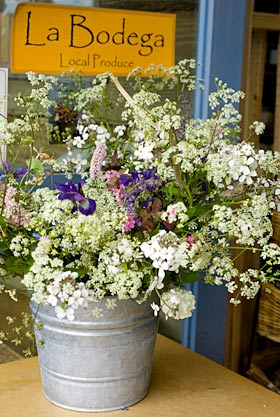
HOW MANY PEOPLE DOES IT TAKE ….. TO BUILD A CLAY OVEN?
Monday October 27th 2008, 11:14 pm
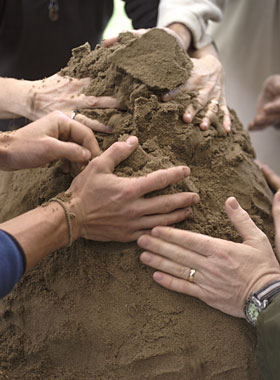
I have been interested in wood-burning bread ovens since seeing one in action on a visit to Australia and when I returned home and began baking my own sourdough bread, this interest turned into an obsession. I fully intended to build an oven in the garden this last summer, but other obligations and rubbish weather meant it just didn’t happen. Even my sourdough starter has been rather neglected lately and is currently sitting at the back of my fridge waiting to be invigorated.
However, I am all fired up after this weekend attending a ‘how to build a bread oven’ course, held at Taurus Crafts, just down the road from where I live. The course leader, Warren Lee Cohen, is a very experienced bread baker and oven builder and he set out to pass on his knowledge and enthusiasm to a group of us eager to learn.

During the course of Saturday and Sunday, 16 of us collaborated – the plan to build 2 ovens; one under a beautifully constructed wooden canopy that would become a permanent feature at Taurus, the other a slightly more modest affair that we would be able to fire and bake in by the end of the second day. The domes of both ovens were made of cob, a mixture of clay, sand and straw, that had to be layered on a groundsheet and then trod, by booted foot (it was just too cold to use bare feet, but apparently you can), to form the correct working consistency to form into bricks. One by one they in turn were then wacked around a mound of sand, manipulated and stroked to seal the gaps between until it all came together to form a domed oven.
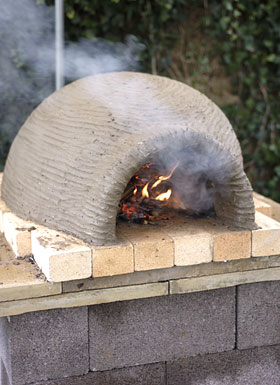
Of course there was a little bit more to it than that, but not much. What was so utterly brilliant was the simplicity of the whole thing. The second oven was made to be be more substantial, had thicker walls, a beautifully crafted oak door so that the oven could be used for baking loaves and was moulded and tended with loving care. The other oven was more basic and though it would have benefitted from a longer drying out time, was fired up by the end of the first day so it could begin to dry out sufficiently for us to bake our pizzas.
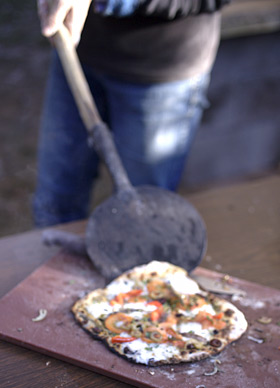
Warren’s approach to sourdough was also surprisingly casual. I have written before about the trials and tribulations of working with a wet dough, getting to grips with hydration and how buying some digital scales and using precise accuracy with weights and measures helped me crack it. Warren doesn’t weigh anything, instead gets the feel of the dough and uses his instinct and experience. It seems a very relaxed way of doing things but I wasn’t the only one who felt slightly traumatised by the thought of simply going with the flow. This approach was refreshing though, after the complicated techniques described in my many books on the subject and proves that there is more than one way to do these things successfully. He had brought in some sourdough for us to use for the pizza bases, which was given a quick kneading in the morning and was ready to use by lunchtime.

By the time we got round to baking, I was starving. We all had the opportunity to make pizzas with whatever topping we chose. Each base was rolled out wafer thin and topped with finely sliced tomatoes, ripped pieces of mozzarella, smearings of pesto, chopped olives, onions, olive oil etc etc. We had to be sure that the oven wasn’t too hot by throwing a handful of flour onto the hot oven floor and counting to ten. If the flour burnt in that time it was too hot, so the oven floor was wiped over with a wet cotton mop a couple of times till it had cooled down enough. The pizzas cooked in a matter of minutes, the thin crusts bubbled up and scorched round the edges, like the bestest ever pizzas you could ever wish for. Each one was cut into wedges and everyone ate so many pieces we all lost track of just how much pizza we had eaten. I’m now desperate to start building my own oven.
ALL AT SIXES AND SEVENS
Wednesday February 06th 2008, 10:18 pm

Sometimes a little knowledge is a dangerous thing. Take for example, if you are already an experienced bread baker, then taking on board new techniques can turn everything on its head and leave you all at ‘sixes and sevens’ (whatever that means).
Before I started on my sourdough journey I had only ever proved my loaves on baking trays or in bread tins, the right way up. Now of course I know to prove my loaves upside down, like the artisan bakers do.
For the final rise the dough shapes should be proved upside down either nestling side by side divided by folds of floured linen (for batons and long shapes) or each in its own banneton, a basket meant especially for this purpose which is either made of coiled cane, which imprints a distinctive coil pattern on the top of the baked loaf, or alternatively a basket lined with linen. Once the dough has risen just right, you flip the loaf over onto a peel or paddle (or metal baking tray) dusted with semolina, so the loaf is then the right way up, and quick as a flash slash the top of the dough with a razor blade (called a lame if you are a real professional), spray it with water and with a quick flick shove the dough into the oven to bake.
The coiled bannetons are a professional bit of kit. You can buy them mail order from here but you can make your own linen lined baskets which look like the real deal. That’s what I’ve done and they work just fine. When you use them they need to be liberally dusted with flour and every now and again if you feel the need you can give them a quick going over with the vacuum cleaner. I can’t say that I ever have, I just whack them against the side of the sink to disslodge any loose flour, make sure they are good and dry and leave them till the next time.
Now lets make a linen-lined banneton. First take a piece of vintage French linen (stop laughing at the back) and a basket….. here’s how
ECSTASY FOR BREAKFAST
Monday January 14th 2008, 12:32 pm

Over the last few days I’ve been busy baking. I first began making sourdough bread last year starting my leaven starter from scratch. Baking for me has always been a comforting activity and I would consider myself experienced at bread baking, but sourdough baking is quite different and requires a different approach. Life was already pretty stressful and growing and feeding the starter almost tipped me over the edge. My sourdough adventure very nearly became a sourdough nightmare.
Years ago I remember a Paddington bear animation on TV where he is making porridge that keeps expanding, oozing its way over the top of the pan and down the side of the cooker until it all goes out of control and the porridge engulfs his house. This cartoon image was one that came to mind many times over those first few weeks. I was using expensive organic flour to feed the leaven and couldn’t bring myself to throw any of it away as day by day it expanded and seemed to take on a life of its own. Then I started to make it into bread and the dough was wet and unmanageable. In the middle of the night I’d be on the forum on Dan Lepard’s website trying to find the key that would make my baking comfort blanket wrap me up all warm and cosy again.
Well, I am nothing if not persistent and I was determined to crack it. Hydration, hydration, hydration I began to chant. I bought some digital scales and measured everything with precision and then it all started to fall into place. I am still not sure that my ‘kneading’ technique is quite like Dan Lepard’s but I can now turn wet sticky dough into a posh loaf, perhaps not yet the smartest-looking artisan bread but not far off.
This morning, for breakfast, I had a slice of the ‘best barm bread ever’ spread with organic butter and homemade damson jam. I closed my eyes and savoured the taste as I was eating it, appreciating every moment. If it wasn’t for the fact that my espresso machine broke last week life would have, for that moment, been pretty damn near perfect.





